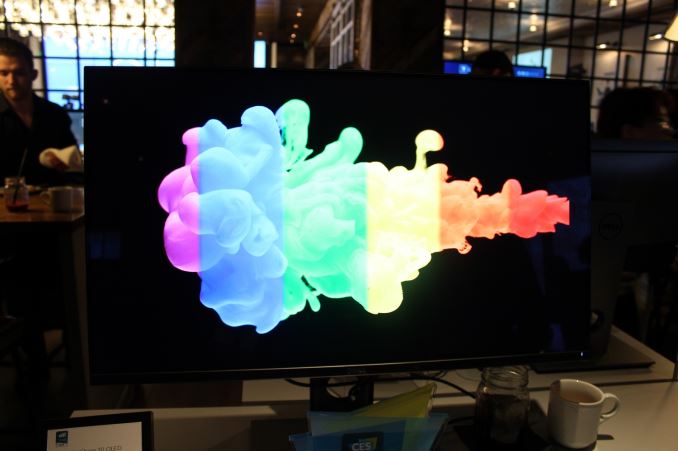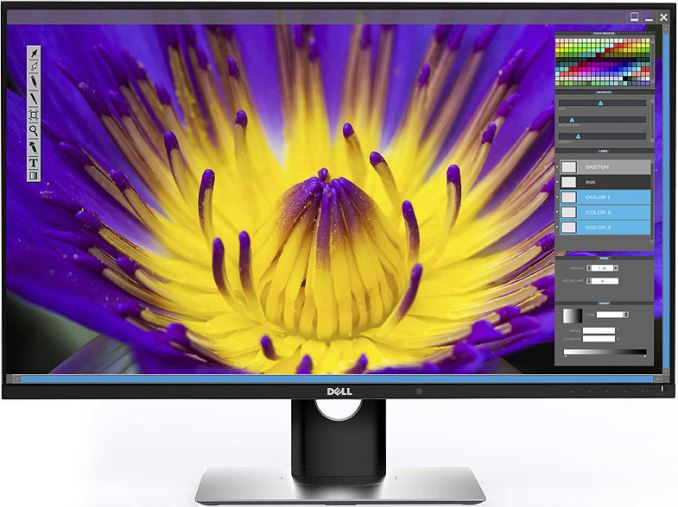Dell Demonstrates 30-inch 4K OLED Display
by Anton Shilov on January 7, 2016 6:40 PM EST- Posted in
- Monitors
- Dell
- Trade Shows
- 4K
- Ultrasharp
- CES 2016
- 30"
- OLED
- UP3017Q

Dell does not produce its own display panels, but when it comes to unique “world’s first” monitors, it is sometimes years ahead of all of its rivals. At the International CES 2016, Dell introduced its UltraSharp 30-inch OLED display, the company’s first monitor to use organic light emitting diode panel. The product is designed for professionals and carries a rather extreme price tag, but this is going to be a dream display for years to come.
The Dell UltraSharp UP3017Q is a 30-inch display with 3840×2160 resolution, 0.1 ms response time and an unknown refresh rate (yet, it should be very high). The monitor can reproduce 1.07 billion colors, it covers 100% of Adobe RGB color space as well as and 97.8% of DCI-P3 color space (used for digital movie projection by the U.S. movie industry and is expected to be adopted in televisions and in home cinema), according to Dell. Just a few professional displays nowadays cover 100% of Adobe RGB. The manufacturer declares 400,000:1 dynamic contrast ratio, but admits the value is only that because testing equipment won't go higher.
The UltraSharp UP3017Q ultra-high-definition display has very narrow bezels; the monitor itself is thin, but not remarkably thin like OLED TVs, possibly because it features internal power supply unit as well as complex logic inside. The monitor features a mini DisplayPort (mDP) connector, an HDMI port as well as a USB type-C port, which could be used for video and data connectivity as well as for power delivery (it can be powered using a type-C cable, or deliver power to another device).
Emissive electroluminescent layer in organic light-emitting diode is made of organic compound that emits light in response to an electric current. The organic semiconductor layer is situated between two electrodes and does not require a backlight. As a result, it can display truly deep black levels, unlike liquid crystal display (LCD) panels, which use various kinds of backlighting. Besides, since the emissive electroluminescent layer is very thin and can take different shapes, it is possible to build ultra-thin and even curved monitors and TVs using OLEDs.
While OLED technology can deliver deep blacks, high contrast ratio and exceptional colours, it is not free of drawbacks. The organic layer may burn down over prolonged amount of time, and colors can shift over time. To maximize lifespan of the OLED panel inside the UltraSharp UP3017Q, Dell integrated a special presence detector into the front panel of the display, which switches the monitor off when nobody uses it. Another disadvantage of OLEDs is a possibility of static image burn in. To reduce the chance of burn in, the UP3017Q has a special pixel-shifting technology.
The Dell UltraSharp 30 OLED monitor will cost whopping $4,999, which it becomes available on March 31, 2016, in the United States. The display at this point is only aimed at professionals, who work in color-critical environments such as graphic arts and photography. However, due to exceptional colors and contrast as well as ultra-fast response time, the UltraSharp UP3017Q will be a dream display for gamers, prosumers and other users, who value quality.
OLED panels are considerably more expensive to produce than modern LCD panels, partly because of lower yields. Last year an executive from LG Electronics said that yields of OLED panels had reached 80% and would continue to grow. At the International CES 2016, Kwon Bong-suk, the head of LG’s TV business, said that the company had cut prices of OLED TVs in the U.S. by 45% late in 2015. As a result, LG now expects sales of OLED televisions to triple this year. Price reduction of OLED TVs indicates that production costs of organic light-emitting diode panels are going down. Perhaps, over time, the Dell UltraSharp UP3017Q will also become more affordable, or Dell will release an OLED display for a wider audience.











83 Comments
View All Comments
nagi603 - Thursday, January 7, 2016 - link
or... you know, use a 5K display, which is a resolution specifically to allow for processing 4K material.Spectrophobic - Thursday, January 7, 2016 - link
Umm... 2160 vertical pixels is still a lot.I'll gladly take it over 2560 x 1600.
Or you know, turn it in portrait mode.
nilepez - Thursday, January 7, 2016 - link
For photo editing, most of my tools are on the sides, not the the top/bottom, so I'd still have to hide all those widgets to see the full image. Obviously more resolution is better, but this really isn't a deal breaker for me.Impulses - Friday, January 8, 2016 - link
You're editing 16:9 photos?mr_tawan - Friday, January 8, 2016 - link
You can rotate the monitor, and suddenly it'd appear tall enough for you :-).RdVi - Thursday, January 7, 2016 - link
When you think what the first 4K LCD monitor from Dell cost this is encouraging. If in two years they can have a 27" 1440p model for <$2000 I'd be tempted. That's if they support adaptive sync. I know these are 'professional' monitors, but that's what I've always found suits my needs best. If I game as well then can't I have the best of both? Unlike their gaming models that use gsync if they are using a top quality scaler already (which they should be) adaptive-sync should be close enough to free.id4andrei - Friday, January 8, 2016 - link
OLED has naturally high refresh rate and CRT like response time. OLED actually does not need GSync or FreeSync. It's naturally fit for gaming monitors.RdVi - Friday, January 8, 2016 - link
It still needs adaptive-sync for when frame rates cannot meet the max refresh, which right now for a 120Hz 4K display is pretty much always with new games. Further more while less noticeable at higher refresh rates, tearing would be a problem without adaptive-sync also.nevcairiel - Friday, January 8, 2016 - link
It still needs them, because otherwise the GPU is limited to sending a fixed frame rate. Both GSync and FreeSync just enable sending variable frame rate to the display.Now OLED might be much more suitable for such displays, surely, but it still needs either of these approaches to actually enable sending variable frame rate content.
Gc - Thursday, January 7, 2016 - link
"... said that yields of OLED panels had reached 80% ..."For what size panel? SmartWatch displays? Phone displays? Yield is a function of defects per area, so yield percentage means little without knowing display area (and maybe pixel size).